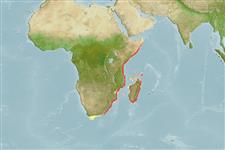>
Ovalentaria/misc (Various families in series Ovalentaria) >
Ambassidae (Asiatic glassfishes)
Etymology: Ambassis: Derived from Greek, anabasis = climbing up (Ref. 45335).
More on authors: Gilchrist & Thompson.
Environment: milieu / climate zone / depth range / distribution range
Ecologia
marinhas; Água doce; estuarina demersal. Subtropical; 13°N - 39°S, 19°E - 52°E
Western Indian Ocean: East coast from KwaZulu-Natal south to Algoa Bay in South Africa (Ref. 4318, 7248, 52193). Reported from east Africa (Ref. 4318), including Madagascar (Ref. 4180, 50956) and Mauritius (Ref. 50956).
Comprimento de primeira maturação / Tamanho / Peso / Idade
Maturity: Lm 3.5 range ? - ? cm
Max length : 10.0 cm SL macho/indeterminado; (Ref. 52193)
Descrição suscinta
Chaves de identificação | Morfologia | Morfometria
Espinhos dorsais (total) : 8; Raios dorsais (total) : 9 - 11; Espinhos anais: 3; Raios anais : 9 - 11. Diagnosis: Ambassis natalensis has following combination of characters: supraorbital spines 1-4; rostral spine absent; rear margin of preopercle entirely serrate; preopercle ridge smooth except for 1-5 tiny spines at rear corner; interopercle smooth or with 1-4 tiny serrae at angle; two rows of cheek scales; predorsal scales 9-11; lateral line continuous; lower gill rakers 19-22; pectoral-fin rays 14-15; teeth on vomer and palatines in 2-3 rows (Ref. 50956).
Tolerant of freshwater within a temperature range of 19-27°C (Ref. 4180, 52193, 79840). In summer, it feeds mainly in early evening and late morning while in winter, it feeds both day and night on crustaceans as well as insects (aquatic and terrestrial) and fish (Ref. 7248, 52193). Excellent subject for biological research as it easily thrives in captivity (Ref. 12484).
Ciclo de vida ou comportamento de acasalamento
Maturidade | Reprodução | Desova | Ovos | Fecundidade | Larvas
Maugé, L.A., 1986. Ambassidae. p. 297-298. In J. Daget, J.-P. Gosse and D.F.E. Thys van den Audenaerde (eds.) Check-list of the freshwater fishes of Africa (CLOFFA). ISNB, Brussels; MRAC, Tervuren; and ORSTOM, Paris. Vol. 2. (Ref. 4180)
Status na Lista Vermelha da UICN (Ref. 130435: Version 2024-1)
Ameaça para os humanos
Harmless
Uso pelos humanos
Pescarias: sem interesse; Aquário: Espécies comerciais; isca: usually
Ferramentas
Relatórios especiais
Baixar XML
Fontes da internet
Estimates based on models
Preferred temperature (Ref.
123201): 23.9 - 27.6, mean 26.7 °C (based on 82 cells).
Índice de diversidade filogenética (Ref.
82804): PD
50 = 0.5000 [Uniqueness, from 0.5 = low to 2.0 = high].
Bayesian length-weight: a=0.01413 (0.00731 - 0.02730), b=3.02 (2.85 - 3.19), in cm total length, based on LWR estimates for this species & Genus-body shape (Ref.
93245).
Nível Trófico (Ref.
69278): 3.4 ±0.59 se; based on food items.
Resiliência (Ref.
120179): Elevada, tempo mínimo de duplicação da população menor que 15 meses (Assuming Fec > 10,000).
Fishing Vulnerability (Ref.
59153): Low vulnerability (10 of 100).
